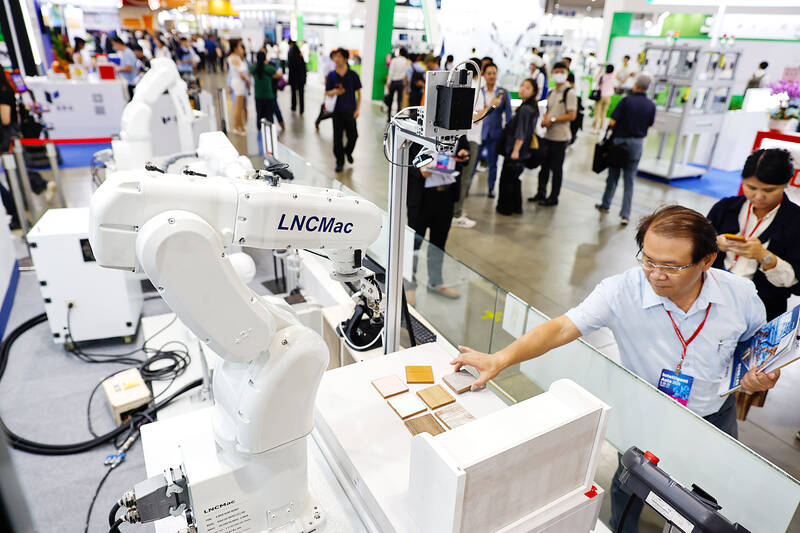Taiwan’s manufacturing sector returned to expansion mode last month for the first time in five months, signaling improving industrial momentum driven by robust global technology demand, the Chung-Hua Institution for Economic Research (CIER, 中華經濟研究院) said yesterday.
The purchasing managers’ index climbed to 50.3 from 48.3 in September, moving back above the 50-point threshold that separates expansion from contraction.
“Factory activity showed signs of recovery following a consolidation period in the third quarter, in line with Taiwan’s strengthening export trend,” CIER president Lien Hsien-ming (連賢明) told a news conference in Taipei.

Photo: EPA
New orders and industrial production led the rebound. The new orders gauge rose 3.9 points to 51.1, while the industrial output sub-index jumped 4.5 points to 53.2, marking a return to expansion for both indicators.
Demand linked to artificial intelligence (AI) continued to fuel orders for power systems, energy-related equipment and cooling solutions, as well as advanced semiconductor packaging and high-bandwidth memory systems, the institute said.
The electrical and machinery equipment sector PMI expanded for the second straight month, rising to 51.8, with orders and output in growth territory. Raw-material costs increased sharply, with the price sub-index accelerating above 60 percent.
Supply-side adjustments among upstream producers — including output cuts and production-line reconfigurations — pushed up prices for precious metals, rare-earth materials, memory chips, central processing units and passive components, the institute said.
Raw material price pressures were particularly sharp in the electronics and optical industry, where the input price index surged 6 points to 68.6, the fastest increase since June 2022 and the 10th consecutive month the index has risen, the institute said.
Despite the improvement in activity, manufacturers remained cautious. The six-month business-outlook gauge stayed in contraction at 43.8, although sentiment improved from September with a 3.5-point gain.
Lien warned that it remains too early to conclude that the impact of tariffs has fully passed, saying that traditional industries continue to face significant strain.
Strong performance in AI-related hardware, energy and machinery sectors helped offset some of the drag, he said.
“The robust momentum in the AI industry is indeed underpinning Taiwan’s economic activity,” Lien said.
In services, the non-manufacturing PMI rose to 54.4 from 52.1, supported by strong third-quarter exports, TAIEX rallies and holiday-driven consumer spending, he said.
While manufacturing and services reported business improvements, companies remain largely guarded.
“It is not clear if the economy will sail smoothly and continue to positively surprise this quarter,” Lien said, urging policymakers and companies to remain cautious.
In related news, Bank of America Corp yesterday raised its forecast for Taiwan’s economic performance this year, lifting its GDP projection from 5.2 percent to 7 percent, as the economy is withstanding a local currency appreciation and US tariffs better than anticipated. That would mark Taiwan’s fastest expansion since 2010.
External headwinds appear to be easing after the US and China reached a trade agreement, the bank added.
The improving geopolitical backdrop could create a more favorable environment for Taiwan’s export-driven economy, it said.
The bank also upgraded its GDP forecast for Taiwan next year to 4.5 percent from 2 percent, citing continued AI-related investment momentum and a recovering global tech cycle.

RUN IT BACK: A succesful first project working with hyperscalers to design chips encouraged MediaTek to start a second project, aiming to hit stride in 2028 MediaTek Inc (聯發科), the world’s biggest smartphone chip supplier, yesterday said it is engaging a second hyperscaler to help design artificial intelligence (AI) accelerators used in data centers following a similar project expected to generate revenue streams soon. The first AI accelerator project is to bring in US$1 billion revenue next year and several billion US dollars more in 2027, MediaTek chief executive officer Rick Tsai (蔡力行) told a virtual investor conference yesterday. The second AI accelerator project is expected to contribute to revenue beginning in 2028, Tsai said. MediaTek yesterday raised its revenue forecast for the global AI accelerator used

Taiwan Semiconductor Manufacturing Co (TSMC, 台積電) has secured three construction permits for its plan to build a state-of-the-art A14 wafer fab in Taichung, and is likely to start construction soon, the Central Taiwan Science Park Bureau said yesterday. Speaking with CNA, Wang Chun-chieh (王俊傑), deputy director general of the science park bureau, said the world’s largest contract chipmaker has received three construction permits — one to build a fab to roll out sophisticated chips, another to build a central utility plant to provide water and electricity for the facility and the other to build three office buildings. With the three permits, TSMC

The DBS Foundation yesterday announced the launch of two flagship programs, “Silver Motion” and “Happier Caregiver, Healthier Seniors,” in partnership with CCILU Ltd, Hondao Senior Citizens’ Welfare Foundation and the Garden of Hope Foundation to help Taiwan face the challenges of a rapidly aging population. The foundation said it would invest S$4.91 million (US$3.8 million) over three years to foster inclusion and resilience in an aging society. “Aging may bring challenges, but it also brings opportunities. With many Asian markets rapidly becoming super-aged, the DBS Foundation is working with a regional ecosystem of like-minded partners across the private, public and people sectors

BREAKTHROUGH TECH: Powertech expects its fan-out PLP system to become mainstream, saying it can offer three-times greater production throughput Chip packaging service provider Powertech Technology Inc (力成科技) plans to more than double its capital expenditures next year to more than NT$40 billion (US$1.31 billion) as demand for its new panel-level packaging (PLP) technology, primarily used in chips for artificial intelligence (AI) applications, has greatly exceeded what it can supply. A significant portion of the budget, about US$1 billion, would be earmarked for fan-out PLP technology, Powertech told investors yesterday. Its heavy investment in fan-out PLP technology over the past 10 years is expected to bear fruit in 2027 after the technology enters volume production, it said, adding that the tech would